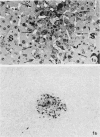Abstract
The organizational pattern of hepatocytes in hyperplastic nodules, probable precursors of hepatocellular carcinoma, was examined sequentially at different stages in the carcinogenic process, and compared with the patterns in hepatocellular carcinomas, in developing liver and in regnerating liver. Scanning as well as transmission electron microscopy, and histochemistry with light microscopy were used. The hepatocytes in the hyperplastic lesions were arranged in plates 2 or more cells thick and glands, in contrast to the one-cell-thick plates of hepatocytes in normal mature liver, and showed unusualy separation from eachother, with irregularly dilated bile canaliculi. The organizational pattern found in the hyperplastic lesions shared properties with developing liver in the perinatal period, regenerating liver following the peak of cell division, and some hepatocellular carcinomas. Unlike the normal, in which there is a highly predictable time scale for change, an apparent delay or interruption of maturation may be of importance in lesions that persist and ultimately evolve into hepatocullular carcinoma.
Full text
PDF








Images in this article
Selected References
These references are in PubMed. This may not be the complete list of references from this article.
- BUCHER N. L. REGENERATION OF MAMMALIAN LIVER. Int Rev Cytol. 1963;15:245–300. doi: 10.1016/s0074-7696(08)61119-5. [DOI] [PubMed] [Google Scholar]
- ELIAS H. Human hepatocarcinoma and the comparative embryology of the vertebrate liver. J Natl Cancer Inst. 1955 Apr;15(5 Suppl):1451–1462. [PubMed] [Google Scholar]
- Fahimi H. D. Perfusion and immersion fixation of rat liver with glutaraldehyde. Lab Invest. 1967 May;16(5):736–750. [PubMed] [Google Scholar]
- Kalengayi M. M., Ronchi G., Desmet V. J. Histochemistry of gamma-glutamyl transpeptidase in rat liver during aflatoxin B1-induced carcinogenesis. J Natl Cancer Inst. 1975 Sep;55(3):579–588. doi: 10.1093/jnci/55.3.579. [DOI] [PubMed] [Google Scholar]
- Koss L. G. Some ultrastructural aspects of experimental and human carcinoma of the bladder. Cancer Res. 1977 Aug;37(8 Pt 2):2824–2835. [PubMed] [Google Scholar]
- Lupulescu A., Pinkus H. Electron microscopic observations on rat epidermis during experimental carcinogenesis. Oncology. 1976;33(1):24–28. doi: 10.1159/000225096. [DOI] [PubMed] [Google Scholar]
- Phillips M. J., Langer B., Stone R., Fisher M. M., Ritchie S. Benign liver cell tumors. Classification and ultrastructural pathology. Cancer. 1973 Aug;32(2):463–470. doi: 10.1002/1097-0142(197308)32:2<463::aid-cncr2820320226>3.0.co;2-m. [DOI] [PubMed] [Google Scholar]
- Potter V. R. Phenotypic diversity in experimental hepatomas: the concept of partially blocked ontogeny. The 10th Walter Hubert Lecture. Br J Cancer. 1978 Jul;38(1):1–23. doi: 10.1038/bjc.1978.159. [DOI] [PMC free article] [PubMed] [Google Scholar]
- Rutenburg A. M., Kim H., Fischbein J. W., Hanker J. S., Wasserkrug H. L., Seligman A. M. Histochemical and ultrastructural demonstration of gamma-glutamyl transpeptidase activity. J Histochem Cytochem. 1969 Aug;17(8):517–526. doi: 10.1177/17.8.517. [DOI] [PubMed] [Google Scholar]
- Solt D. B., Hay J. B., Farber E. Comparison of the blood supply to diethylnitrosamine-induced hyperplastic nodules and hepatomas and to the surrounding liver. Cancer Res. 1977 Jun;37(6):1686–1691. [PubMed] [Google Scholar]
- Solt D. B., Medline A., Farber E. Rapid emergence of carcinogen-induced hyperplastic lesions in a new model for the sequential analysis of liver carcinogenesis. Am J Pathol. 1977 Sep;88(3):595–618. [PMC free article] [PubMed] [Google Scholar]
- WILSON J. W., GROAT C. S., LEDUC E. H. HISTOGENESIS OF THE LIVER. Ann N Y Acad Sci. 1963 Dec 30;111:8–24. doi: 10.1111/j.1749-6632.1963.tb36945.x. [DOI] [PubMed] [Google Scholar]









